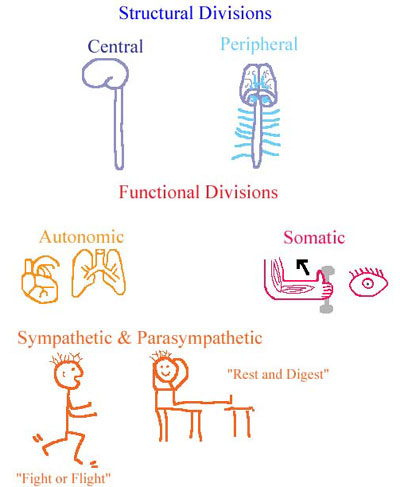 At this point, you should have a basic picture of the organization of the nervous system in your mind. To recap, the nervous system is responsible for all the activities of your body from digestion to emotion. The nervous system is built from a network of neurons with billions of synapses allowing all the parts of your body to communicate. We divide the nervous system structurally into the central nervous system and the peripheral nervous system. The central nervous system consists of the brain and spinal cord, and the peripheral nervous system consists of the nerves outside the brain and spinal cord (12 pairs of cranial nerves, 31 pairs of spinal nerves and all their branches). We also divide the nervous system functionally into somatic and autonomic systems. The somatic nervous system consists of those functions of which we are aware, and the autonomic nervous system consists of those functions of which we are unconscious. The autonomic nervous system may be divided further into sympathetic and parasympathetic components that interact to regulate homeostasis.
At this point, you should have a basic picture of the organization of the nervous system in your mind. To recap, the nervous system is responsible for all the activities of your body from digestion to emotion. The nervous system is built from a network of neurons with billions of synapses allowing all the parts of your body to communicate. We divide the nervous system structurally into the central nervous system and the peripheral nervous system. The central nervous system consists of the brain and spinal cord, and the peripheral nervous system consists of the nerves outside the brain and spinal cord (12 pairs of cranial nerves, 31 pairs of spinal nerves and all their branches). We also divide the nervous system functionally into somatic and autonomic systems. The somatic nervous system consists of those functions of which we are aware, and the autonomic nervous system consists of those functions of which we are unconscious. The autonomic nervous system may be divided further into sympathetic and parasympathetic components that interact to regulate homeostasis.
All the components of the nervous system interact to allow us to do all the things that make us uniquely human, from speaking to feeling emotions to learning complex information. You will go on to learn many more details about how the nervous system functions, but maintaining a general picture about its organization will go a long way towards making the details of the nervous system clearer. |






 At this point, you should have a basic picture of the organization of the nervous system in your mind. To recap, the nervous system is responsible for all the activities of your body from digestion to emotion. The nervous system is built from a network of neurons with billions of synapses allowing all the parts of your body to communicate. We divide the nervous system structurally into the central nervous system and the peripheral nervous system. The central nervous system consists of the brain and spinal cord, and the peripheral nervous system consists of the nerves outside the brain and spinal cord (12 pairs of cranial nerves, 31 pairs of spinal nerves and all their branches). We also divide the nervous system functionally into somatic and autonomic systems. The somatic nervous system consists of those functions of which we are aware, and the autonomic nervous system consists of those functions of which we are unconscious. The autonomic nervous system may be divided further into sympathetic and parasympathetic components that interact to regulate homeostasis.
At this point, you should have a basic picture of the organization of the nervous system in your mind. To recap, the nervous system is responsible for all the activities of your body from digestion to emotion. The nervous system is built from a network of neurons with billions of synapses allowing all the parts of your body to communicate. We divide the nervous system structurally into the central nervous system and the peripheral nervous system. The central nervous system consists of the brain and spinal cord, and the peripheral nervous system consists of the nerves outside the brain and spinal cord (12 pairs of cranial nerves, 31 pairs of spinal nerves and all their branches). We also divide the nervous system functionally into somatic and autonomic systems. The somatic nervous system consists of those functions of which we are aware, and the autonomic nervous system consists of those functions of which we are unconscious. The autonomic nervous system may be divided further into sympathetic and parasympathetic components that interact to regulate homeostasis.